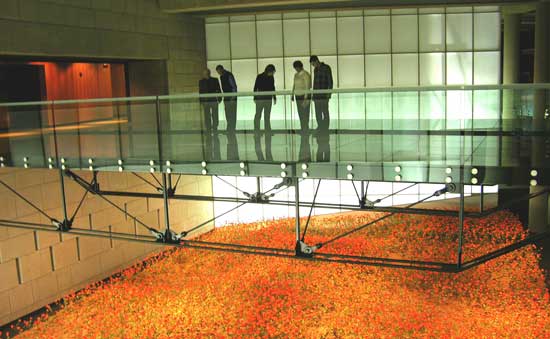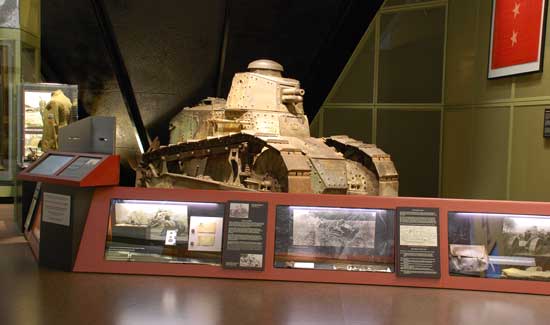

A damaged war machine, officially known as a Renault FT-17 tank and commonly used by American forces during World War I, rests in retirement on a museum floor, still nursing its permanent wound in the shape of a gaping hole. A posted marker indicates that a German 77-millimeter artillery piece, like one on view, was responsible.
Nearby, visitors walk through a man-made crater, standing where a French farmhouse would have been had it not been struck by a 17-inch howitzer shell.
Not far away, one can peer into recreated trenches, the sights accompanied by sounds of bullets flying and soldiers tramping through mud.
And on a wall, iconic Uncle Sam glares from a war poster admonishing, “I want you for (sic) U.S. Army.”
This was World War I, and this is the National World War I Museum in Kansas City, opened to the public in 2006.
In some ways World War I, fought between 1914 and 1918, has become the forgotten war for Americans, but that never should have been allowed to happen. Some confuse it with World War II. A few years back, a nationally known reporter asked a brigadier general visiting the museum, “Did you fight in World War I?”
It’s not all ancient history. Metaphorically, the world was fighting World War I as recently as the 1990s. The Balkan civil wars of the mid-1990s could easily be viewed as an extension of the war.
But most people know little about the war once known as The Great War, which ended on the 11th hour of the 11th day of the 11th month of 1918 — the day we Americans now celebrate as Veterans Day, once known as Armistice Day.

Museum spokesperson Denise Rendina said, “A lot of people know so much about World War II but nothing about World War I. The museum starts at the ground and builds the story for them.”
One enters the complex by crossing a recreated Western Front poppy field, reminiscent of the famed John McCrae poem, “In Flanders Field.” Each of the poppies represents 1,000 dead combatants. The actual museum is divided into two sections — one covering the years 1914-1917, before the United States entered the war, and the other delving into the years the United States took an active role in the fighting, 1917-1918.
Why was it fought? An enigmatic statement spoken by a narrator begins an introductory multi-media presentation: “No one can say precisely why it happened — which may be, in the end, the best explanation for why it did.”
The war did have a multitude of causes: social unrest, nationalism, ethnic pride, long-standing alliances naively meant to maintain a balance of power, and the match that lit the powder keg: the assassination of Archduke Franz Ferdinand, heir to the throne of the empire of Austria-Hungary, by a young Bosnian Serb named Gavrilo Princip.
The introductory video ends with the sounds of two gunshots, and a declaration that within one week after the assassination, seven European nations were at war with one another.
The details are told through an extensive timeline, the mass of which may seem intimidating. Then again, perusing the timeline is the only way to uncover such little known gems as the following from 1916: Future author “J.R.R. Tolkien takes part in the Battle of the Somme.
Tolkien’s first experience on the front comes on a Friday, July 14, with an unsuccessful attack on the village of Ovillers. His unit is later relieved after days of fighting.”

As at most modern museums, interactive exhibits engage visitors on personal and creative levels. You can use a light pen to design your own patriotic — or propaganda — poster, then email it home, or determine the uses of camouflage.
Or take some time to listen to fighting men’s letters read aloud as you look inside a typical trench. A German soldier gets teary-eyed on Christmas Eve in 1915, thinking about life in his hometown that night as he keeps company withhis own little tree in his trench.
A Belgian lieutenant complains about rats in his trench. A French infantryman offers, “Shells of all calibers kept raining on our sector. The trenches had disappeared, filled with earth. The air was unbreathable (sic). Our blinded, wounded, crawling and shouting soldiers kept falling on top of us and died splashing us with their blood. It was living hell.”
As the political map evolved as a result of World War I, so did the means of warfare. A virtual armory is here. Body armor, straight from the legends of Lancelot and Arthur, was tried early on, but soon tanks became the ultimate battlefield weapon.
Yet no other dimension of the war saw such fast-paced high tech advances as air combat. The heavier-than-air flying machine, just a decade past its birth at Kitty Hawk, evolved from a reconnaissance machine to fighters, dropping bombs, strafing trenches and gunning for one another.
By the end of the war, pilots were flying planes with two or three wings and maneuvering swiveling mounts for a second machine gunner. A replica of a biplane hangs from the ceiling, an ideal example of the growth of air warfare during the conflict.
The home front is also represented. A poster calls on women at home to do their part. “Joan of Arc saved France,” is printed above a photo of the martyred saint. It continues, “Women of America. Save Your Country. Buy War Savings Stamps.”
Representing the other side are the posted words of a 12-year-old German schoolgirl, Piete Kuhr: “Another collection has been announced at school, for copper, tin, lead, zinc, brass, and old iron … I turned the whole house over from top to bottom. Grandma cried, ‘Why don’t you give them your lead soldiers instead of cleaning me out?’ So my little army had to meet their deaths.”
The museum building has its own intriguing history. It opened in 1926 with a tower and two exhibit halls. By the 1990s the property was declared unsafe.
City leaders decided to convert the expansive space under the original structure into a state of the art museum. The two original galleries are used mainly for rotating exhibits, and yes, one can take an elevator and short stairway to the tower summit as World War I veterans did shortly after they returned stateside decades ago.
If You Go
Hours: Year round, summer, daily and major Monday holidays, 10-5; rest of year, daily except non-holiday Mondays, 10-5. Closed Thanksgiving, Christmas Eve, Christmas Day and New Year’s Day.
Admission: $14 adults; $12 ages 65 up and active and career retired military with ID; students ages 18 and up with ID; $8 ages 6-17.
Information: National World War I Museum, 100 West 26th Street, Kansas City, Mo. 64108, (816) 888-8100, www.theworldwar.org
Lodging: Sheraton Suites Country Club Plaza, 770 West 47th Street, (816) 931-4400, doubles: $129-$309, https://www.sheratoncountryclubplaza.com; Holiday Inn Aladdin Kansas City (boutique hotel), 1215 Wyandotte Street, (816) 421-8888, doubles: $109-$229 https://www.hialaddin.com; Sleep Inn, 7611 NW 97th Terrace, (816) 891-0111, doubles: $54.99-$64.99, continental breakfast included, https://www.sleepinn.com
Note: This is barbecue country. Some of Kansas City’s highly regarded barbecue restaurants include: Arthur Bryant’s Barbecue (three locations), https://www.arthurbryantsbbq.com/index.htm Fiorella’s Jack Stack Barbecue (four locations), https://www.jackstackbbq.com/ Gates Bar-B-Q (six locations) https://www.gatesbbq.com/ and Oklahoma Joe’s Barbecue (three locations), https://www.oklahomajoesbbq.com/
- How to Get Around in Sydney: A Local’s Guide to Traveling Around Sydney - April 24, 2024
- The Low-Key Magic of Ghent, Belgium - April 22, 2024
- Discover the Hidden Charm of Extremadura in Spain - April 20, 2024
